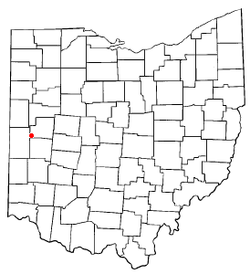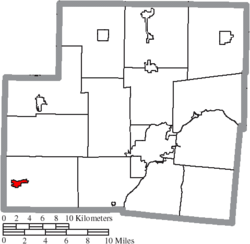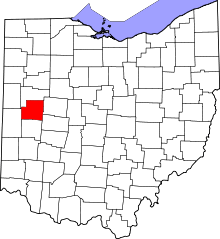Russia, Ohio
| Russia, Ohio | |
|---|---|
| Village | |
|
St. Remy Catholic Church, a community landmark | |
 Location of Russia, Ohio | |
 Location of Russia in Shelby County | |
| Coordinates: 40°14′5″N 84°24′37″W / 40.23472°N 84.41028°WCoordinates: 40°14′5″N 84°24′37″W / 40.23472°N 84.41028°W | |
| Country | United States |
| State | Ohio |
| County | Shelby |
| Government | |
| • Mayor | Terence Daugherty |
| Area[1] | |
| • Total | 0.79 sq mi (2.05 km2) |
| • Land | 0.78 sq mi (2.02 km2) |
| • Water | 0.01 sq mi (0.03 km2) |
| Elevation[2] | 970 ft (295 m) |
| Population (2010)[3] | |
| • Total | 640 |
| • Estimate (2012[4]) | 647 |
| • Density | 820.5/sq mi (316.8/km2) |
| Time zone | Eastern (EST) (UTC-5) |
| • Summer (DST) | EDT (UTC-4) |
| ZIP code | 45363 |
| Area code(s) | 937 |
| FIPS code | 39-69344[5] |
| GNIS feature ID | 1049142[2] |
| Website | http://www.russiaoh.com/ |
Russia /ˈruːʃiː/ is a village in Loramie Township, Shelby County, Ohio, United States. The population was 640 at the 2010 census. The correct local pronunciation is "roo-shee", with the emphasis on the first syllable. The town is home to one school, Russia Local School, which is grades K-12. The school's athletic programs' mascot is the Raider.
History
Russia was founded by Lewis Phillips, who purchased and plotted the land where the village now sits. Phillips' house, built in 1853, was the first house in Russia; other settlers followed by the late 1850s. Phillips was also the first businessman in the village, opening a grocery store in 1853. Later settlers soon founded a dry goods store and multiple sawmills; Russia's economy was once heavily dependent on its sawmills. Among the earliest settlers were French speaking Suisse who had served under L. Napoleon Bonaparte during the war with Russia. [6]:365 According to tradition, the village's name commemorates a battle these veterans had fought in Russia.[7]
Russia was established in an area that was already predominately French. In the early part of the nineteenth century, a large number of emigrants from Alsace, Lorraine, and other parts of France settled in southwestern Shelby County and the adjacent portions of northeastern Darke County. Besides Russia, these immigrants founded the communities of Frenchtown and Versailles. By the middle of the 1850s, the heavily Roman Catholic population had grown to the point that multiple parishes were established in the area. A log church was built and dedicated to Saint Remigius, the patron saint of France, and Mass was first celebrated there on June 15, 1854. The congregation soon outgrew its building and constructed a new brick church; when it became too small, a larger brick church was constructed and completed in 1892.[6]:367 Today, St. Remy's Catholic Church dominates Russia's skyline. The village is one of many small communities in a heavily Catholic region of western Ohio known as the "Land of the Cross-Tipped Churches".[8]
Geography
Russia is located at 40°14′5″N 84°24′37″W / 40.23472°N 84.41028°W (40.234696, −84.410416).[9]
According to the United States Census Bureau, the village has a total area of 0.79 square miles (2.05 km2), of which 0.78 square miles (2.02 km2) is land and 0.01 square miles (0.03 km2) is water.[1]
Government
- Terence Daugherty – Mayor
- Mark Shappie – Village Administrator
- Law Enforcement by Shelby County Sheriff
- Village Council
- Ron Simon – President
- Greg Borchers
- Mary Jo High
- Cindy Goubeaux
- Lawrence Platfoot
- John Grogean
- Steve Rose – Superintendent of Schools
Demographics
| Historical population | |||
|---|---|---|---|
| Census | Pop. | %± | |
| 1880 | 91 | — | |
| 1970 | 420 | — | |
| 1980 | 438 | 4.3% | |
| 1990 | 442 | 0.9% | |
| 2000 | 551 | 24.7% | |
| 2010 | 640 | 16.2% | |
| Est. 2015 | 656 | [10] | 2.5% |
The median income for a household in the village was $56,035.
2010 census
As of the census[3] of 2010, there were 640 people, 224 households, and 173 families residing in the village. The population density was 820.5 inhabitants per square mile (316.8/km2). There were 242 housing units at an average density of 310.3 per square mile (119.8/km2). The racial makeup of the village was 99.2% White and 0.8% from two or more races. Hispanic or Latino of any race were 0.2% of the population.
There were 224 households of which 44.2% had children under the age of 18 living with them, 65.6% were married couples living together, 7.6% had a female householder with no husband present, 4.0% had a male householder with no wife present, and 22.8% were non-families. 21.9% of all households were made up of individuals and 12.1% had someone living alone who was 65 years of age or older. The average household size was 2.86 and the average family size was 3.34.
The median age in the village was 31.6 years. 35% of residents were under the age of 18; 8% were between the ages of 18 and 24; 24% were from 25 to 44; 19.8% were from 45 to 64; and 13.1% were 65 years of age or older. The gender makeup of the village was 48.4% male and 51.6% female.
References
- 1 2 "US Gazetteer files 2010". United States Census Bureau. Retrieved 2013-01-06.
- 1 2 "US Board on Geographic Names". United States Geological Survey. 2007-10-25. Retrieved 2008-01-31.
- 1 2 "American FactFinder". United States Census Bureau. Retrieved 2013-01-06.
- ↑ "Population Estimates". United States Census Bureau. Retrieved 2013-06-17.
- ↑ "American FactFinder". United States Census Bureau. Retrieved 2008-01-31.
- 1 2 Hitchcock, Almon Baldwin Carrington (1913). History of Shelby County, Ohio, and representative citizens. p. 365.
- ↑ Overman, William Daniel (1958). Ohio Town Names. Akron, OH: Atlantic Press. p. 121.
- ↑ Brown, Mary Ann and Mary Niekamp. National Register of Historic Places Inventory/Nomination: Cross-Tipped Churches Thematic Resources, 6. National Park Service, July 1978. Accessed 2010-02-26.
- ↑ "US Gazetteer files: 2010, 2000, and 1990". United States Census Bureau. 2011-02-12. Retrieved 2011-04-23.
- ↑ "Annual Estimates of the Resident Population for Incorporated Places: April 1, 2010 to July 1, 2015". Retrieved July 2, 2016.
- ↑ "Census of Population and Housing". Census.gov. Retrieved June 4, 2015.

